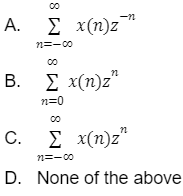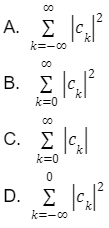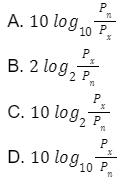Digital signal processing consists of techniques that enhance the reliability and efficiency of digital communication. There are numerous mathematical techniques and algorithms that can be applied to analogue or digital signals for its processing. In the real world, it is crucial to convert analogue signals like sound, temperature, or light into a form that can be transmitted, displayed, and analysed. It forms the basics of any telecommunication system, radar, sonar, medical technology, video coding, control systems, seismology, digital image processing, and beyond. Some of the techniques for digital signal processing are bilinear transform, minimum phase, z-transform, s-plane, filter design, transfer function, and discrete-time fourier transform.
Multiple Choice Questions
1. What is the solution called when the input of the system is assumed to be zero?
A. Complete solution
B.General solution
C. Homogeneous solution
D. Particular solution
Answer: C
2. How is the complete solution of any difference equation given?
A. yp(n) – yh(n)
B. yp(n) * yh(n)
C. yp(n) + yh(n)
D. yh(n) – yp(n)
Answer: C
Let x(n) be the input signal, y(n) be the response, and h(n) be the unit sample response of the system. What is the relation given by
A. Convolution difference
B. Convolution sum
C. Convolution product
D. Convolution division
Answer: B
What is the correct sequence of procedures to perform on h(n) to convolute x(n) and y(n)?
Folding shifting multiplication with x(n)summation
Multiplication with x(n)summation folding shifting
Summation folding shifting multiplication with x(n)
Shifting summation folding multiplication with x(n)
Answer: 1
What is the necessary condition for an LTI system to be causal in nature?
A. For negative value of n, impulse response should be non-zero
B. For positive value of n, impulse response should zero
C.For negative value of n, impulse response should be zero
D. For positive value of n, impulse response should be non-zero
Answer: C
What is the value of discrete-time signal x(n) for the value of n being non-integer?
A. Positive
B. Negative
C. Undefined
D. Zero
Answer: C
How is the unit ramp signal defined in discrete-time function?
A. u(n)=n for n≥0;u(n)=0 for n<0
B. u(n)=n for n≤0;u(n)=0 for n>0
C. u(n)=n for n>0;u(n)=0 for n≤0
D. None of these
Answer: A
What is the condition for a real-valued signal to be antisymmetric in nature?
A. x(n)=-x(n)
B. x(n)=x(-n)
C. x(n)=-x(-n)
D. None of these
Answer: C
What is another term used for time scaling operation in digital signal processing?
A. Upsampling
B. Downsampling
C. Convolution
D. Quantisation
Answer: B
Which of the following functions represents impulse function?
A. x(n)=n for n≥0;x(n)=0 for n<0
B. x(n)=1 for n=0;x(n)=0 for n≠0
C. x(n)=0 for n=0;x(n)=1 for n≠0
D. x(n)=n for n≤0;x(n)=0 for n>0
Answer: B
The autocorrelation of a discrete signal x(n) is represented by which of the given equations?
A. rxy(l)=x(l)-x(-l)
B. rxy(l)=x(l)+x(-l)
C. rxy(l)=x(l)x(-l)
D. rxy(l)=x(l)x(l)
Answer: C
Which of the following is the type of discrete system?
A. Non-causal systems
B. Recursive systems
C. Dynamic systems
D. All of the above
Answer: D
What is another term used for two-sided Z transform?
A. Bilateral Z-transform
B. Unilateral Z-transform
C. Trilateral Z-transform
D. None of these
Answer: A
What is zero padding technique?
A. Zeroes are added at the end of the sequence to make the number of samples equal to a power of two.
B. Zeroes are added at the start of the sequence to make the number of samples equal to a power of two.
C. Zeroes are added anywhere in between the sequence to make the number of samples equal to a power of two.
D. None of the mentioned.
Answer: A
How many complex additions are needed for 16 direct computations in discrete Fourier transform?
A. 56
B. 240
C. 756
D. 32
Answer: B
Solution- number of total complex additions = N(N – 1)
N = 16
Complex additions = 16(16 – 1)
= 240
Which of the following statements is invalid about linear convolution?
A. It needs zero padding.
B. The sequence length of input and output is the same.
C. The input and output sequence is aperiodic.
D. All the above statements are valid.
Answer: B
17. In the divide and conquer approach, the equation to calculate total complex additions is ________
A. N (M + L + 2)
B. N (M + L – 3)
C. N (M + L – 2)
D. N (M – L + 1)
Answer: C
Which of the following properties is correct for FIR (Finite Impulse Response) filters?
A. FIR filters are generally canonical
B. FIR filters are not always stable
C. FIR filters require less memory than IIR filters
D. FIR filter’s linear phase realisation structure can not be designed easily
Answer: A
19. Which technique is used to obtain a discrete-time signal from a continuous-time signal?
A. Differentiating
B. Convolution
C. Integrating
D. Sampling
Answer: D
20. What is the method of joining steps in the digital to analogue conversion known as?
A. Quadratic interpolation
B. Staircase approximation
C. Linear interpolation
D. None of the above
Answer: B
21. What should be the minimum frequency of sampling to avoid aliasing?
A. F/2 ( here, F is the analogue signal frequency)
B. F
C. 2F
D. 4F
Answer: C
22. Which of the following factors provides the quality of output from the A/D converter?
A. Quantisation to signal noise ratio
B. Signal to quantisation noise ratio
C.Quantisation error
D. None of the above
Answer: B
23. In RADAR signal application, which of the following elements is unnecessary?
A. Digital signal processor
B. A/D converter
C. D/A converter
D. All of the above
Answer: C
24. Which of the following correctly represents the Z-transform X(z) of a discrete-time signal x(n)?

Answer- A
25. For a sequence of finite duration with anti-causal property, the Z-transform ROC is ________
Entire z-plane, except at z = ∞
Z = 0
Entire z-plane, except at z = 0
Z = ∞
Answer- A
26. In which condition of ROC is a linear time-invariant system called BIBO stable?
The ROC of the system is a unit circle
The ROC of the system includes unit circle
The ROC of the system excludes unit circle
None of the above
Answer- B
27. Which of the following equations represents a periodic signal x(t)’s average power?

Answer: A
28. Which of the following system functions represents an all pass filter?
A. H(z)=zk
B. H(z)=z-k
C. H(z)=z1/k
D. H(z)=z2k
Answer: B
29. In an invertible system, _____
A. The input and output signals have many to one correspondence
B. The input and output signals have many to many correspondences
C. The input and output signals have one to many correspondences
D. The input and output signals have one to one correspondence
Answer: D
30. In which of the following applications digital signal processing is used?
A. Space applications
B. Biomedical applications
C. Video processing
D. All of the above
Answer: D
31. Which of the following is/are common applications of IIR filters?
A. Audio equalisation
B. IoT/IIoT smart sensors
C. High-speed RF applications
D. All of the above
Answer: D
32. In the Overlap add method to compute N point DFT, M-1 zeroes are added _________.
A. At the first of each data block
B. At the last of each data block
C. In between the data block
D. No zeroes are added
Answer: B
33. In a single complex-valued multiplication, the number of quantisation errors is ______.
A. Three
B. Four
C. Seven
D. Two
Answer: B
34. In a logarithmic scale, the Signal-to-Quantisation Noise ratio is expressed as _______.

Answer:D
35. What is the nature of truncation error in the case of representation of a number in two’s complement?
A. Zero
B. Always positive
C. Always negative
D. Can’t say
Answer: C
36. In which of the following transformations, the poles of the transformation and the poles of matched z-transform are identical?
A. Impulse transformation
B. Approximation of derivatives
C. Bilinear transformation
D. None of the above
Answer: A
37. Which of the following is/are the frequent applications of Hilbert transform?
A. Bandpass signals representation
B. SSB signals generation
C. Minimum phase type filter designing
D. All of the above
Answer: D
 Profile
Profile Settings
Settings Refer your friends
Refer your friends Sign out
Sign out







